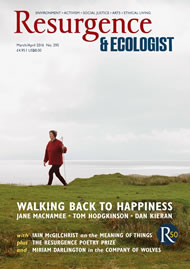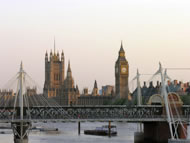Around two years ago I moved back to London after spending 12 years living in a remote farmhouse on the north coast of Exmoor. Pretty much every day for those 12 years my wife Victoria and I would go for at least an hour’s walk along the coastal path. It was a supremely beautiful stretch: we rambled 500 feet above the sea and on a clear day we could see the coast of Wales across the Bristol Channel. Gorse, smelling of coconut, and oak trees grew on the steeply sloping cliffs, and in spring every day was different, as primroses gave way to foxgloves and then whortleberries in the summer. We would often see deer and sometimes find a dead mole.
We were going to miss our daily walks, that was for sure. Shepherd’s Bush could not compare with the wilds of Devon when it came to beauty.
But I soon came to realise that there is a different kind of beauty to be had in London: architectural beauty. The beauty of crowds and bustle. And it’s free to walkers. My old friend Marcel rang up to suggest that we take a Friday off and go for a walk around town. At first I said that I could only take half a day, citing work pressures. Then I changed my mind: surely one of the advantages of being a freelance-journalist-stroke-entrepreneur was that I could take a full day off if I wanted to?
So we met in Patisserie Valerie on Piccadilly at 9.30am for an espresso. Then at ten we set off, flâneurs of the 21st century, without any particular plan in mind. We walked down to The Mall and then across St James’s Park, which always makes me think of James Boswell and his indiscretions next to trees with women of the night. Then across Parliament Square, where we paused to look at Big Ben. “That’s not actually Big Ben,” said Marcel. “The bell is called Big Ben. But the tower is called Elizabeth Tower.” A bit of a pedant, is Marcel.
Then we walked over Westminster Bridge, and who could not be reminded of another romantic rambler, William Wordsworth, and the lines he wrote describing the beauty of London in the early morning?
Earth has not anything to show more fair:
Dull would he be of soul who could pass by
A sight so touching in its majesty.
And this was surely bliss, to be wandering without purpose around old London town with an old friend? At a cost of nought pounds – we brought our own sandwiches to save on café prices: such are the little acts of thrift that must be made in middle age – we were enjoying ourselves immensely. This felt like a terrific indulgence. And of course it is a treat that could be given to yourself in any city: all cities have hidden treasures to offer, things to see, places to dawdle.
On we went. Past the London Eye and along the river by the South Bank, where a sandcastle artist sat in his creation and played the ukulele. Eccentricity lives. Past the skateboarders, past those men who paint themselves grey and stand on one foot for money, past the Globe theatre, past magnificent yuppie flats, past run-down housing estates with young mums pushing prams and old men drinking cans of beer in the entranceways. Past the oddly amateurish-looking statue of Peter the Great and his dwarf in Deptford. Marcel translated the Russian text, before we realised that there was a translation provided on the other side of the statue.
On and on, past a city farm – yes, pigs and sheep in the city! – where we sat on a bench to eat our sandwiches. Then on again till we reached the great tunnel at Greenwich where the river widens. Lazily, I suggested that we catch the ferry back to the Tate Gallery in Pimlico, but hardy Marcel would hear none of it, so on we walked. We walked through the tunnel and took some silly photographs halfway along. We had a chat with the man who runs the kiosk as you emerge on the other side.
Then along the river on the other side, past the old pubs of Wapping. We stopped at a Chinese supermarket and paused on a set of steps that led down to the river. Our legs were starting to ache. We walked along the river as much as we could; often the riverside path stops and you have to detour inland a bit and find your way back. We had to wait and watch as a road bridge was winched into the air to let a boat into a marina from the river. Is it my imagination, or is the river being used a little more once again? It should be.
We walked on past the Tower of London, where a polar bear was kept in the late 13th century. Marcel told me who the king was at that time. I forget now. Edward?
We were very lucky indeed with the weather: the sun shone warm and bright all day, though it was October. I even got tanned.
We went slightly north past St Paul’s Cathedral and found an old-fashioned sweet shop. I spent two pounds on a bag of sweets – the only outlay of the day. To think that bankers spend a thousand pounds a night in Mayfair nightclubs to snatch a bit of pleasure before returning to their toil in the morning!
To walk is to taste sweet freedom. It is of course a real tonic to get out of the city and into Nature, but it is equally a tonic to get out of the countryside and into the city. We walked that day for seven hours and covered 15 miles. We saw beautiful and unusual things. We talked non-stop. I would have traded years of therapy for those hours. I returned home in a cheerful mood. This beautiful act of walking in cities: it is democratic, available, luxurious. Anytime, anywhere. Try it in your own city.
I am continuing to walk in London. Marcel and I took my 15-year-old son on a three-hour ramble through town the other day, and Victoria encourages me to walk with her to our office, which is about an hour’s walk from our house.
Londoners may with good reason object to the money that has poured into the capital lately. But even the most ornery must concede that, aesthetically speaking, the money has been a good thing. The parks and streets have never looked grander and cleaner and more beautiful. There is a lot of joy on offer, and it’s free if you choose to take it.







